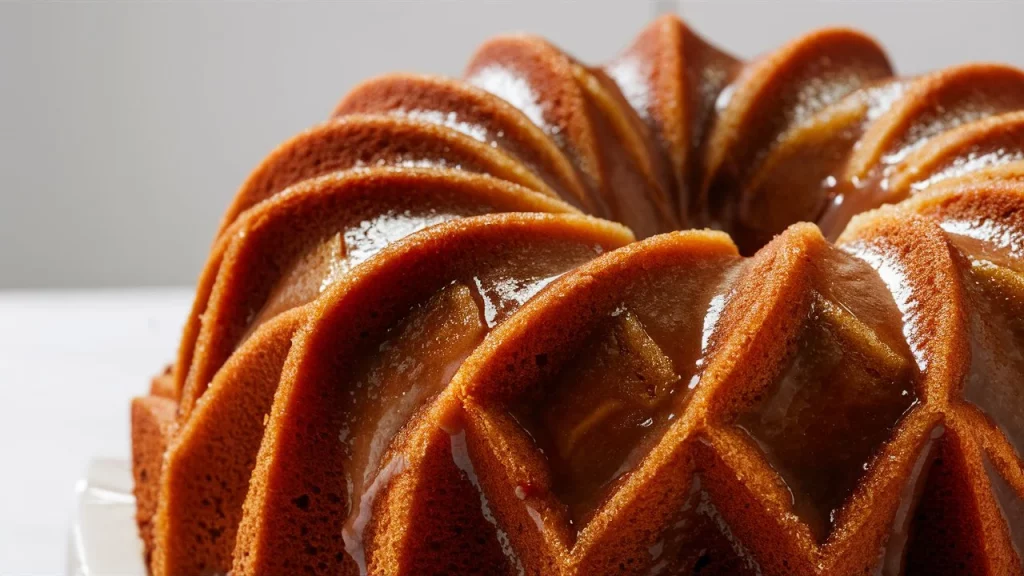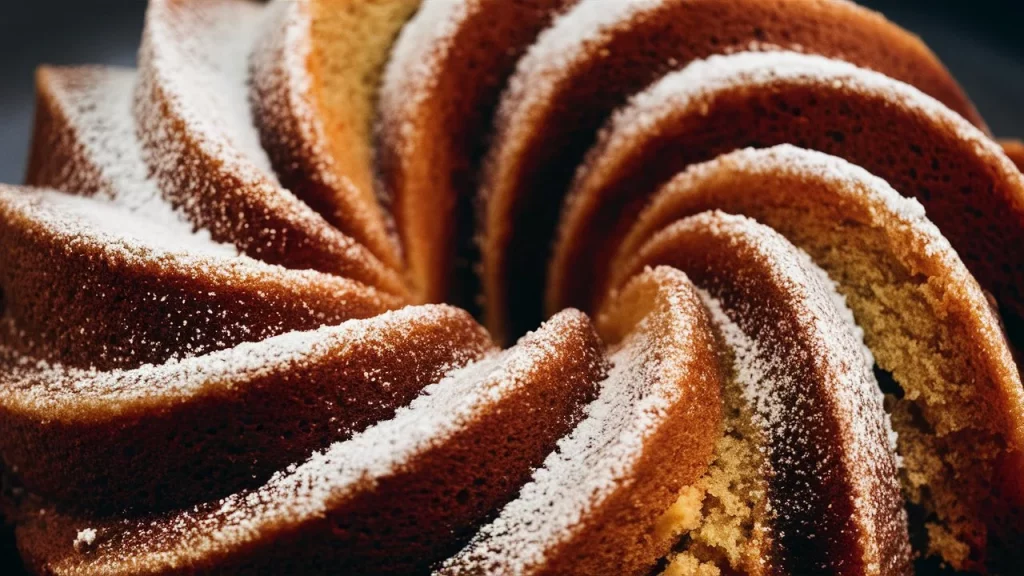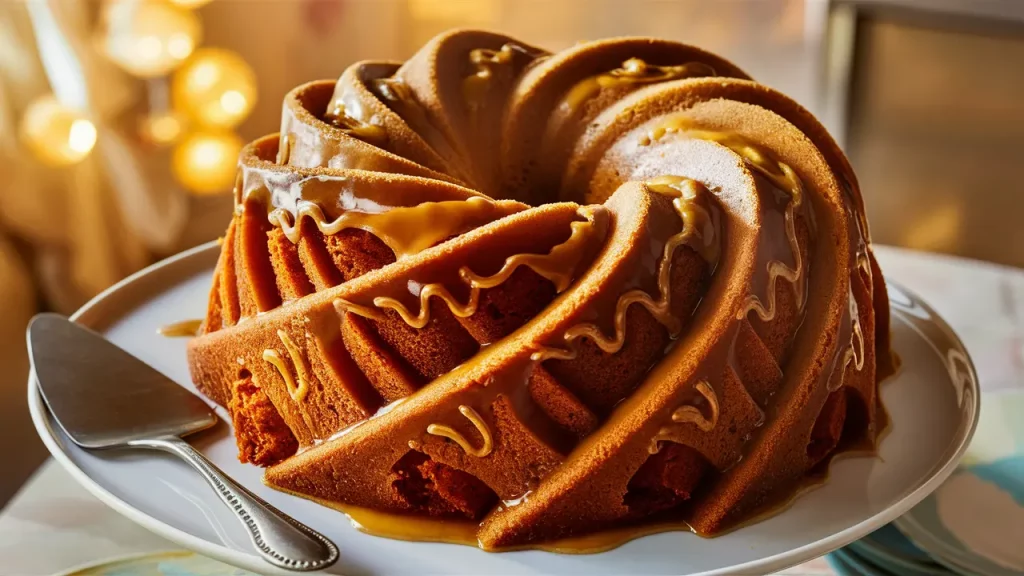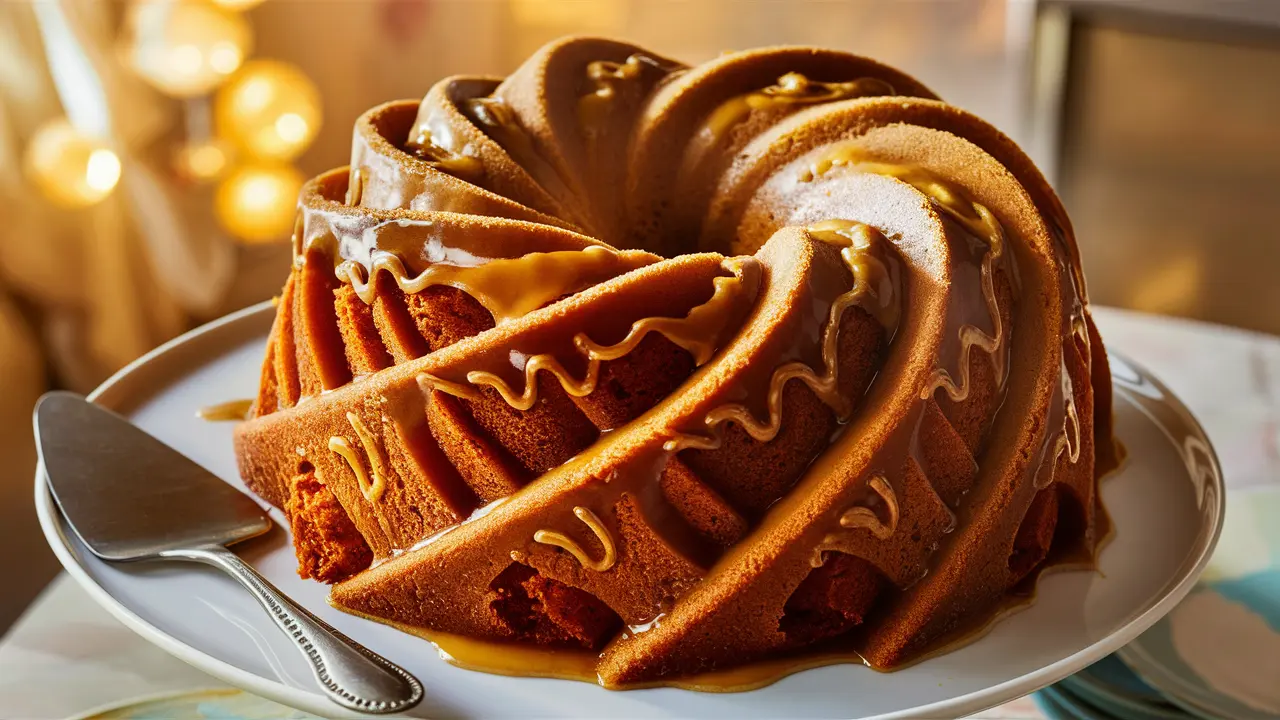What Makes a Bundt Cake Different?
Bundt cakes are unique for several reasons, from their historical origins and distinctive ingredients to their iconic shape which impacts the baking process.
Historical Origins of Bundt Cakes
The European Influence on Bundt Cake Designs
Bundt cakes trace their roots back to European bakes like the German Gugelhupf, which is a yeast-based cake often enjoyed during festive occasions. The modern Bundt cake, however, was popularized in America in the mid-20th century by Nordic Ware, a company founded by a Jewish-American immigrant. He adapted the traditional heavy, ceramic or cast iron Gugelhupf molds to lighter, more user-friendly aluminum. The distinct fluted design of these pans was inspired by the traditional European cake molds, making Bundt cakes a blend of old-world charm and modern convenience.
Key Ingredients That Define a Bundt Cake
The Role of Butter and Sugar
Butter and sugar are fundamental to the Bundt cake’s rich texture and flavor. The creaming of butter and sugar introduces air into the mix, creating a light and fluffy texture. This process is critical as it sets the foundation for the cake’s structure. Butter also contributes to the rich flavor that Bundt cakes are known for.
Importance of Eggs in Texture
Eggs play a crucial role in Bundt cakes, acting as an emulsifier and providing moisture. They help to bind the ingredients together and contribute to the overall richness and density of the cake. The proteins in eggs also give the cake structure and stability, allowing it to rise beautifully while maintaining its moisture during the longer baking times required by the thick shape of Bundt cakes.
The Signature Shape and Its Impact
How the Hole in the Middle Affects Baking
The signature ring shape of a Bundt cake is not just for aesthetics; it has a practical purpose. The central tube or ‘hole’ allows heat to penetrate the cake more evenly, which is essential given the dense nature of most Bundt cake batters. This design helps the cake to bake thoroughly without the outside becoming overdone before the middle has cooked through. The shape also creates more surface area, allowing for a delightful crust to form around the entire cake, which is often enhanced by glazes or toppings that settle into the grooves.
In summary, a Bundt cake’s appeal lies in its rich history, essential ingredients, and distinctive ringed design, all of which contribute to its unique texture, flavor, and cooking requirements. These elements make Bundt cakes not only a treat to eat but also a visually impressive item to present at gatherings.
Comparative Analysis: Bundt vs. Regular Cake

Bundt cakes and regular cakes share basic ingredients and purposes but differ significantly in texture, flavor profiles, and versatility in recipes. These differences can influence a baker’s choice depending on the occasion, desired presentation, and flavor.
Texture Differences
- Bundt Cake: Bundt cakes are typically denser and moister than many regular cakes due to their ingredient ratios and cooking method. The thick batter and central tube design of the Bundt pan allow for even baking, which helps retain moisture throughout the cake. Additionally, the crust that forms on the outside of a Bundt cake provides a pleasant contrast to the soft interior, enhancing the textural experience.
- Regular Cake: Regular cakes, such as layered cakes or sheet cakes, often have a lighter, airier texture compared to Bundt cakes. This is achieved through the use of different leavening agents, ratios of ingredients, and mixing methods that incorporate more air into the batter. Regular cakes might also vary more in texture, from fluffy angel food cakes to slightly denser pound cakes.
Flavor Profiles and Flexibility in Recipes
- Bundt Cake: Bundt cakes excel in rich, deep flavors. They often feature ingredients like nuts, fruits, spices, and chocolate, which meld well during the longer baking times. The shape of the pan allows for creative flavor combinations, as glazes and sauces can pool into the grooves of the cake, providing an enhanced flavor with every bite. The structure of Bundt cakes also supports a variety of dense, rich batters that might not work as well in other types of cake pans.
- Regular Cake: Regular cakes offer a broad canvas for flavor experimentation. They can range from sweet and simple vanilla cakes to complex flavor combinations involving different layers and fillings, such as fruit jams, custards, and creams. The flexibility of shape and size in regular cakes makes them suitable for a wider range of decorating techniques, which can also influence the overall flavor profile through the addition of icings, fondants, and other decorative elements.
Both Bundt and regular cakes have their unique appeal and uses. Bundt cakes are often favored for their rustic charm and ease of preparation, making them ideal for less formal occasions or as the centerpiece of a brunch or dinner party. Regular cakes, on the other hand, might be chosen for their versatility and the artistic possibilities they present, particularly for celebrations and formal events where appearance is just as important as taste.
Baking Techniques for Perfect Bundt Cakes
Achieving perfection with Bundt cakes involves mastering specific baking techniques, particularly in regards to temperature, timing, and greasing the intricate pans. These elements are crucial for ensuring that your Bundt cake is baked evenly and releases cleanly from the pan.
Temperature and Timing Tips
- Optimal Oven Temperature: Most Bundt cakes bake well at 350°F (177°C). This moderate temperature allows the cake’s thick batter to cook through evenly without the exterior burning. It’s important to preheat your oven for at least 20 minutes to ensure it’s at the right temperature before the cake goes in.
- Check Oven Accuracy: Use an oven thermometer to verify your oven’s temperature settings. Some ovens can be off by a significant amount, affecting the baking time and final result.
- Baking Time: Due to their thickness and density, Bundt cakes generally require a longer baking time than regular cakes—often between 45 to 60 minutes. Start checking for doneness at the lower end of the time range by inserting a skewer or toothpick into the thickest part of the cake. If it emerges clean or only slightly moist, then the cake is ready.
- Avoid Overbaking: Keep a close eye on the cake as it nears the end of the baking time. Overbaking can dry out a Bundt cake, making it tough rather than moist.
Greasing Techniques: Ensuring a Perfect Release
- Thorough Greasing: Properly greasing the pan is critical to ensure your cake releases without sticking. Use a pastry brush to apply a liberal coat of melted butter or a special non-stick baking spray (which contains flour) into every nook and cranny of the pan. Make sure all surfaces are covered, including the center tube.
- Flouring the Pan: After greasing, some bakers like to add an extra layer of protection by flouring the pan. Sprinkle a light dusting of flour over the greased surface, then tap and turn the pan to spread the flour evenly. Flip the pan over and knock out any extra flour.
- Alternative Dusting Options: Instead of flour, you can dust the greased pan with granulated sugar or cocoa powder (for chocolate cakes). This not only prevents sticking but also adds a subtle flavor and texture to the outer crust of the cake.
- Cooling Before Unmolding: After baking, cool the cake in the pan on a wire rack for about 10 minutes. This allows the cake to set and detach itself from the sides of the pan slightly, making it easier to unmold. Don’t let it cool too long, though, as the sugar in the cake can begin to stick to the pan as it cools.
- Unmolding the Cake: Place a cooling rack over the top of the Bundt pan, invert both, and gently lift the pan off the cake. If the cake resists, tap lightly on the pan with a spoon or gently pull away from the edges to loosen.
These tips for temperature control, timing, and greasing will help ensure that your Bundt cake turns out as beautiful in appearance as it is delicious in taste. With a little practice and attention to detail, you can master the art of Bundt cake baking.
Creative Variations of Bundt Cakes

Bundt cakes are known for their versatility and capacity to incorporate a wide range of flavors and textures. Creative variations involving fruits, nuts, glazes, and toppings can transform a basic Bundt cake into a spectacular dessert that appeals to both the eye and the palate.
Incorporating Fruits and Nuts
- Fruit Additions: Fruits can be added to Bundt cake batter in various forms: fresh, dried, or as preserves. Fresh fruits like apples, pears, bananas, and berries add moisture and subtle natural sweetness. When using heavier fruits, such as cherries or large berries, coat them lightly in flour to prevent them from sinking to the bottom during baking.
- Citrus and Zest: Incorporating citrus flavors like lemon, orange, or lime zest can brighten the overall flavor of the cake. You can also add citrus juice to the batter for a more pronounced taste.
- Nuts for Texture and Flavor: Adding nuts such as walnuts, pecans, almonds, or hazelnuts provides a crunchy texture contrast and a nutty flavor that complements both the fruity and rich profiles of Bundt cakes. Toasting the nuts before adding them to the batter can enhance their flavor and crunch.
Experimenting with Glazes and Toppings
- Simple Glazes: A simple glaze made from powdered sugar and milk or lemon juice can dramatically enhance the visual appeal and taste of a Bundt cake. The glaze should be pourable but thick enough to form a nice coating that adheres to the grooves of the cake.
- Flavorful Glazes: Experiment with different flavors in your glazes. Vanilla, almond, and citrus glazes are popular, but you can also try incorporating fruit purees, espresso, or liqueurs to align the glaze flavor with the cake’s character.
- Chocolate Ganache: For a richer topping, pour warm chocolate ganache over the cake. Ganache, made from chocolate and cream, provides a glossy and luxurious finish that is visually striking against the detailed surface of a Bundt cake.
- Caramel or Fruit Sauces: Drizzling caramel sauce or a vibrant fruit coulis can add a touch of elegance and a burst of complementary flavors.
- Decorative Toppings: After glazing, add toppings such as sliced almonds, coconut flakes, or edible flowers before the glaze sets. These not only add texture but also make the cake more visually appealing.
- Sugared Edibles: For a subtle sparkle and added texture, consider garnishing your cake with sugared herbs like rosemary or mint, or even candied citrus slices.
These creative variations allow you to tailor Bundt cakes to specific tastes or occasions, making them as simple or as elaborate as desired. Whether subtly enhanced with fruit and nuts or decadently draped in rich glazes and elegant toppings, Bundt cakes offer a canvas for bakers to express their creativity and delight their guests.
Common Challenges and Solutions
When baking Bundt cakes, even experienced bakers can encounter a few common problems. Here are the challenges and their solutions to ensure your Bundt cake turns out perfectly every time.
Avoiding Undercooked Centers
- Challenge: Due to their thick and dense nature, Bundt cakes can sometimes appear done on the outside while remaining undercooked in the center.
Solutions: - Proper Oven Temperature: Ensure your oven is properly calibrated. An oven thermometer can help check this. Bake the cake at 350°F (177°C), which is generally ideal for even cooking.
Baking Time: Give the cake sufficient time to bake. Check doneness by inserting a long skewer into the cake’s thickest part. If it comes out clean or with just a few moist crumbs, the cake is done. - Position in the Oven: Bake the cake in the center of the oven where temperature distribution is most even. Avoid opening the oven door frequently, as this can cause temperature fluctuations that affect cooking.
Dealing with Sticking Issues
- Challenge: Bundt cakes are notorious for sticking to their intricate pans, making them difficult to release.
- Solutions: Proper Greasing: Use a baking spray that contains flour, or brush every crevice of the pan with melted butter and then dust it with flour. Make sure all surfaces are completely covered.
- Time the Unmolding Correctly: Allow the cake to cool in the pan on a wire rack for exactly 10 minutes. Cooling too long can cause sugar in the cake to crystallize, which makes sticking worse.
- Loosen Edges: Before attempting to turn out the cake, run a thin, flexible knife around the edges of the pan, including the central tube, to loosen any stuck parts.
Expert Tips for Mastering Bundt Cake Recipes
Gaining insights from professional bakers can elevate your Bundt cake baking skills. Here are some expert tips collected from renowned bakers:
Advice from Renowned Bakers
- Ingredient Quality: Opt for premium ingredients to achieve the best outcomes. For example, real butter and pure vanilla extract make a significant difference in flavor.
- Room Temperature Ingredients: Make sure all your ingredients, particularly butter, eggs, and dairy products, are at room temperature to ensure a homogenous batter that bakes evenly.
- Do Not Overmix: Once the flour is added, mix the batter just until the ingredients are combined. Overmixing can develop the gluten too much, leading to a tough cake.
- Bake Immediately: Once the batter is mixed, get it into the oven as soon as possible. Letting the batter sit can affect the rise of the cake.
- Cool Down Properly: After cooling in the pan for 10 minutes, invert the cake onto a cooling rack and let it cool completely before slicing or adding glaze. This avoids condensation, which can make the cake soggy.
Incorporating these tips and solutions into your baking process can help you overcome common Bundt cake challenges, resulting in a cake that is as delicious as it is beautiful. Whether you’re a novice or a seasoned baker, these insights will assist you in achieving Bundt cake perfection.
Cultural Significance of Bundt Cakes

Bundt cakes have carved a unique niche in culinary traditions, particularly in the United States, where they have become a symbol of home-style comfort and celebration.
Bundt Cakes in Modern Celebrations
Often selected for their aesthetic appeal and the nostalgia they evoke, Bundt cakes are popular at various celebrations such as birthdays, holidays, and anniversaries. Their distinctive ring shape not only serves as an ideal centerpiece for gatherings but also symbolizes community and continuity. In many cultures, this circular form represents wholeness and eternity, adding meaningful depth to special occasions.
Future Trends in Bundt Cake Baking
As culinary trends evolve, so do the flavors and techniques used in Bundt cake baking. The future of Bundt cakes looks bright and innovative, with new flavors and baking methods emerging.
Innovations and New Flavors in the Bundt Cake World
- Flavor Innovation: The exploration of unconventional flavor combinations is one of the most exciting trends in Bundt cake baking. Bakers are increasingly incorporating global ingredients and flavors, such as matcha, lavender, and turmeric, to appeal to modern palates and curiosity about different cultures’ cuisines.
- Health-Conscious Recipes: There’s a growing trend towards healthier baking, which includes Bundt cakes made with alternative flours, natural sweeteners, and functional ingredients that provide health benefits beyond basic nutrition. Examples include almond flour for a gluten-free option or coconut sugar for a lower glycemic index.
- Savory Bundt Cakes: While traditionally sweet, there’s a new trend towards savory Bundt cakes. Ingredients like herbs, cheeses, and sun-dried tomatoes are being used to create Bundt cakes that can be served as part of a meal rather than as a dessert.
- Mini Bundt Cakes: Miniaturization is a trend across various food categories, and Bundt cakes are no exception. Mini Bundt cakes are becoming popular for their convenience at events, allowing for a variety of flavors to be offered to guests and making portion control easier.
- Eco-Friendly Baking: With a growing awareness of environmental issues, more bakers are adopting sustainable practices, from sourcing ingredients locally to using eco-friendly packaging for their cakes.
As Bundt cakes continue to evolve, both in flavor and form, they remain a beloved tradition that adapts to fit the times while still celebrating its rich, storied past. These trends not only make Bundt cakes exciting to bake but also more integrated into the broader culinary landscape, reflecting changing tastes and values.

